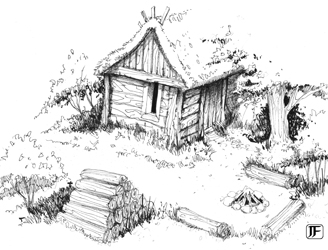Hagaard (Upper Urgolia)

- Area Square Miles: 222,500

 The rough area in square miles of that nation.
The rough area in square miles of that nation. - Population: 1,112,500 (5/sq. mile)

 The total population, including all significant humanoid races, plus the average population per square mile.
The total population, including all significant humanoid races, plus the average population per square mile. - Racial Balance: Human (66%), Goblin (7%), Elf (6%), Orc (6%), Halfling (4%), Dwarf (2%), Gnome (2%), Half-orc (1%), Half-elf (1%), Other (5%)

 The details of all the major races of that country, as a percentage of the total population.
The details of all the major races of that country, as a percentage of the total population. - Capital City: Maraput (pop. 1500)

 The capital city of that country, if it has one, along with its population.
The capital city of that country, if it has one, along with its population. - Government: See below

 The political structure for that nation, if any. This will be one of: autocracy, confederation, democracy, despotism, dictatorship, imperial, monarchy, oligarchy, republic or tribal. By far, the most common form of government is monarchy.
The political structure for that nation, if any. This will be one of: autocracy, confederation, democracy, despotism, dictatorship, imperial, monarchy, oligarchy, republic or tribal. By far, the most common form of government is monarchy. - World View: See below

 The attitude of each nation toward its neighbors (passive, defensive or aggressive) and a number of terms that best sum that nation up (ie agricultural, nomadic, seafaring, wild, etc). Each nation can have one or more such terms, but will only ever have one attitude.
The attitude of each nation toward its neighbors (passive, defensive or aggressive) and a number of terms that best sum that nation up (ie agricultural, nomadic, seafaring, wild, etc). Each nation can have one or more such terms, but will only ever have one attitude. - Religion: Arak Kal, Concei Japur, Crayver, Ordal, Urgomond, Uther, Yerraz; Babbarax, Gygafrak; Ky, Ney Allond, Tannun Maruth, Vihahn; Ragmannon, Xagraxsus; Ogden, Thim; Kavak; Gungorn

 The main gods esteemed by that nation. The list reflects the racial balance statistics (see above); so if humans are the largest racial group in that nation, followed by elves and dwarves, the list of deities follwed by humans will be first, then elves and dwarves. Within this context, they are listed alphabetically. No deity is listed more than once, even if more than one racial group prays to that god (for instance, both elves and gnomes are likely to follow Ky, but it will only be listed once nonetheless).
The main gods esteemed by that nation. The list reflects the racial balance statistics (see above); so if humans are the largest racial group in that nation, followed by elves and dwarves, the list of deities follwed by humans will be first, then elves and dwarves. Within this context, they are listed alphabetically. No deity is listed more than once, even if more than one racial group prays to that god (for instance, both elves and gnomes are likely to follow Ky, but it will only be listed once nonetheless). - Languages: Aish, Rhuven, Urgolian, Yait

 The main languages spoken by the people of that nation, listed alphabetically.
The main languages spoken by the people of that nation, listed alphabetically. - Climate: Temperate

 The climate of that nation, from: arctic, continental cool summer, humid subtropical, subarctic, subtropical, temperate, tropical, warm temperate.
The climate of that nation, from: arctic, continental cool summer, humid subtropical, subarctic, subtropical, temperate, tropical, warm temperate.
Overview
Hagaard is also now known as Upper Urgolia, having long since been consumed into the Urgolian empire, where the wars with the elves of The Endless Forest and the many humanoids that occupy these wild lands continue. Although there are many small settlements along the banks of The Syramassa River, the people are predominately nomadic. However, nomadic or otherwise, tribute must be paid to the Great Nuhata of Urgolia in both gold and the annual handpicking of their sons and daughters for those who will become the future warriors of Urgolia.
Ruled by the Nuhata's Hand in Maraput, Hagaard is now consumed by war. Within its own borders, the large numbers of humanoids are a constant threat and make regular raids against the Urgolian settlements and the nomadic tribes. With so many humanoid warbands, alliances between them are common, as are wars between the different tribes and races. On rare occasions, large unified humanoid armies emerge which go on the rampage, destroying human and humanoid foe alike and it has not been unknown for Urgolians to make temporary alliances with other humanoid tribes to help defeat these dangerous enemies.
To the north of Hagaard, a war with the elves of The Endless Forest has been ongoing since the Urgolians first invaded these lands and attempted to move north beyond The Golden Peaks, where they met with stiff resistance from the wood elves there. Open war is rare, with quick raids and brutal skirmishes common practice. The expert horsed Urgolian archers against the precision of the elven archers makes combat a deadly affair, with losses running high on both sides.
Brief History
See Urgolia for a brief history of Hagaard.
The Major Towns and Cities
Maraput: (pop: 1,500) By the standards of virtually anyone else, Maraput would be nothing more than a small town. In Hagaard, however, it is its principle and largest city, with rude huts and tents the standard fare, dominated by the occasional stone building. The tents, however, can be elaborate affairs, with even the rich preferring them to stone or wooden buildings. Bazaars are common, with the people selling their goods or bringing entertainment to the muddy streets.

